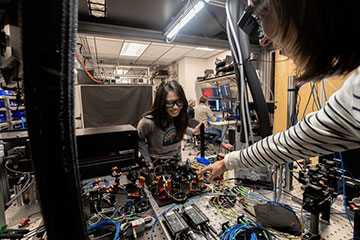
Lightsynq's quantum interconnect lab. [Image: Courtesy of Lightsynq]
Lightsynq, USA, a Boston-based startup, was launched on 19 November after raising US$18 million in Series A funding to build technology that could enable quantum computers to scale to commercially useful sizes. Lightsynq will leverage synthetic diamonds with unique optical properties from Element Six (E6), a division of the De Beers Group, UK, to address the network loss associated with extracting quantum information out of computing modules.
“Diamond holds immense potential for quantum computing,” said Mihir Bhaskar, CEO and cofounder of Lightsynq. “It’s important for Lightsynq to have a trusted strategic partner such as Element Six on board to put this technology to the test,” he continued.
The startup’s initial round of venture-capital financing was led by Cerberus Capital Management, with contributions from Murata Electronics North America Inc., IAG Capital Partners, Safar Partners, QVT and In-Q-Tel (IQT), in addition to E6. Lightsynq was founded by former research scientists at Amazon Web Services’ Center for Quantum Networking (AWS CQN)—a team with which E6 has been collaborating since 2015.
Building memories with diamonds
Quantum computing has a wide range of potentially transformative applications in drug development, financial modeling, artificial intelligence and more. However, to date, the field has been constrained by the technical challenges associated with scaling individual systems, including error rates and limited qubit numbers. Lightsynq’s team members are among the many quantum physicists and companies around the world looking for solutions to this problem.
“E6’s engineered materials will allow Lightsynq to build faster and more robust solutions to unlock several factors of computational capabilities in sectors such as chemistry and cybersecurity,” said Siobhán Duffy, the CEO of E6, which makes synthetic diamonds at a manufacturing facility in Oregon, USA.
Quantum memories are the only known approach for building loss-tolerant connections between quantum computers. According to Lightsynq, their quantum memories are created by embedding silicon atoms into diamond to form silicon vacancy color centers (SiVs)—two-qubit registers that are controllable using microwave pulses.
SiVs have high-quality optical transitions for rapid qubit initialization and readout. In addition, by placing SiVs in optical cavities, Lightsynq says it can achieve high-fidelity, high-efficiency interactions between single photons and the SiV's electron qubit. The company will implement all of this in a photonic integrated circuit (PIC)—potentially enabling the startup to scale to many parallel memory registers.
Proof-of-concept research
The company’s cofounders were among the authors of a March 2020 paper published in Nature showing the first memory-enhanced quantum link based on color centers in diamond photonic circuits. The study demonstrated that the link works faster with their quantum memories than without.
In another Nature paper from May 2024, researchers from Harvard University, USA, and the AWS CQN—including Lightsynq’s cofounders—reported creating a multi-node quantum network that distributes, stores and processes quantum information.
A bright future
By placing SiVs in optical cavities, Lightsynq says it can achieve high-fidelity, high-efficiency interactions between single photons and the SiV's electron qubit.
Lightsynq says the new Series A funds will go directly toward building the first quantum interconnect prototypes around diamond-based PICs. They note that this approach offers several advantages, including the ability to perform universal quantum logic operations on their quantum memory register and enable in-memory Bell-state measurements for entanglement swapping. Other technologies often struggle with this step due to inherent inefficiencies when using linear optics for Bell-state measurements, according to Lightsynq.
Another key feature of Lightsynq’s interconnects is “heralded” memory operation, which automatically detects the successful storage of a photon in the memory, allowing for the establishment of high-fidelity connections despite losses.
Lastly, broad acceptance bandwidth of the SiV's optical interface means that Lightsynq can work with photons from diverse quantum hardware platforms, ranging from narrow-bandwidth atoms and ions to more broadband solid-state systems.
According to a LinkedIn post from Lightsynq cofounder Bart Machielse, “Our solution will provide a pathway to foundry-scale production of quantum interconnects, enabling more usable qubits across a network accelerating commercial applications of quantum computing.”
